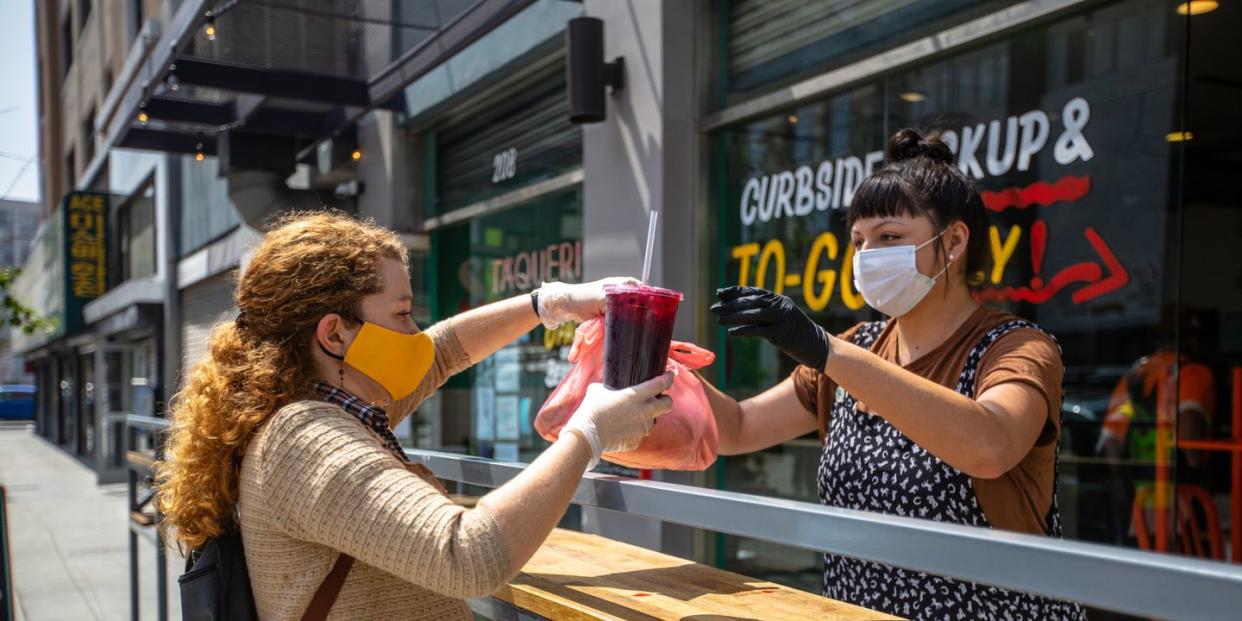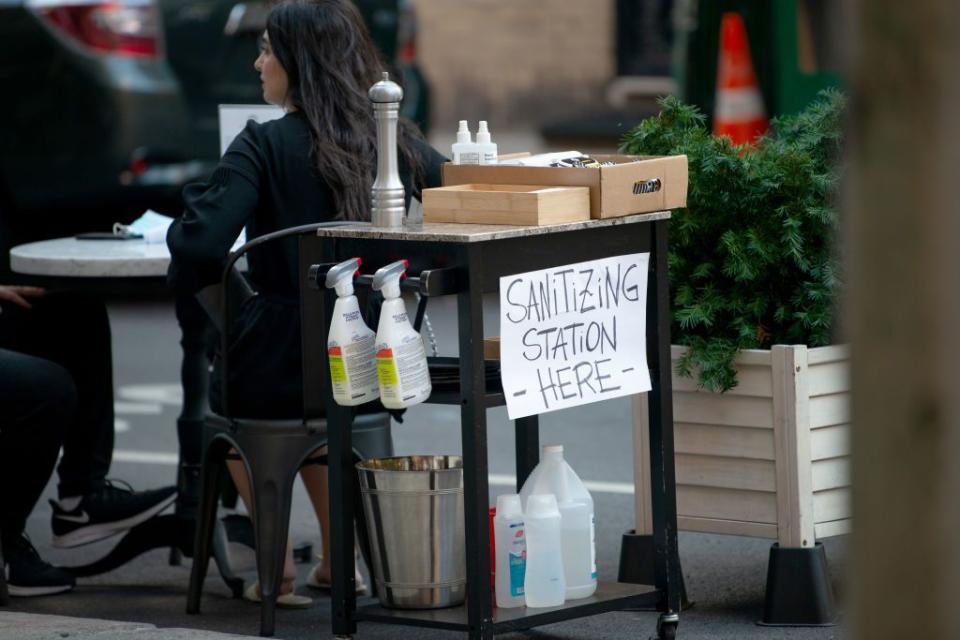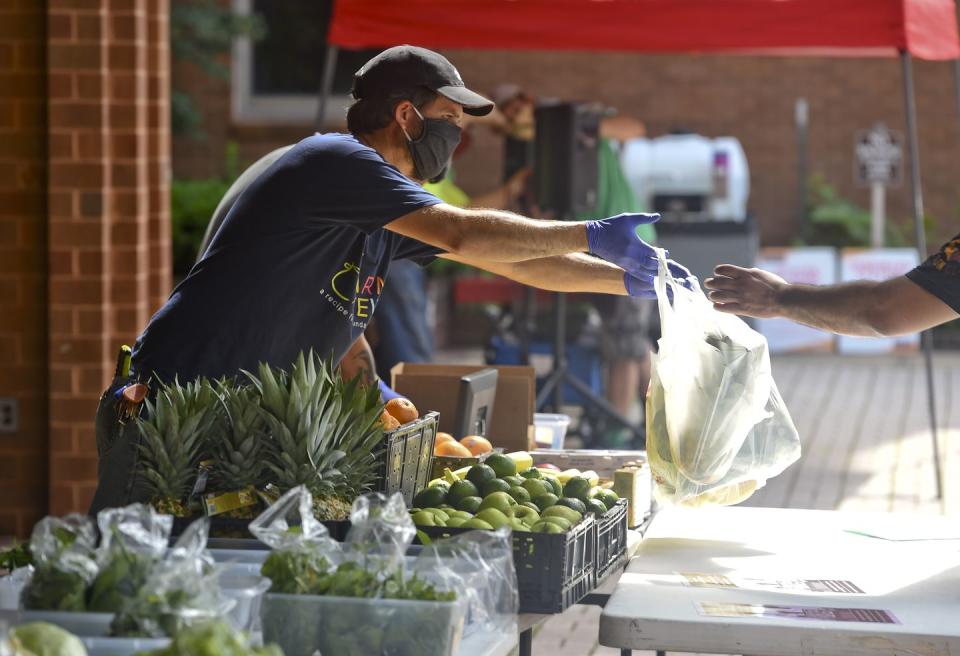Your Risk Level Of Contracting COVID-19 With These 23 Summer Activities, According To Experts

It's summer, but make no mistake, the COVID-19 pandemic is still very much raging on in the United States. We all have to face that this summer is probably going to look pretty different than others we've experienced, but that doesn't mean you have to stay inside 100 percent of the time. We asked experts to weigh in on a bunch of summer activities and evaluate their risk level.
But here's the thing: Evaluating risk is not a clear-cut exercise. Activities don't fall neatly into "risky" and "safe" categories, especially because there are typically dozens of factors at play. Generally speaking, every time you interact with someone outside of your household, you are putting yourself at risk of COVID-19 exposure. All of these recommendations should be taken with a grain of salt, and you may want to exercise more caution based on your own comfort level, age, location, and the health status of you and those around you.
"In general, being outside is better than being inside, being farther apart is better than being close together, smaller numbers of people are better than larger numbers of people, and being sure that nobody who is getting together is not feeling well," said Hilary Babcock, MD, a professor of medicine in the Division of Infectious Diseases and medical director of the Infection Prevention and Epidemiology Consortium for BJC HealthCare.
Ryan Malosh, an infectious disease epidemiologist at the University of Michigan School of Public Health, provided similar guidance, adding the importance of wearing a mask.
And now, here's what they had to say about 23 common summertime activities.
Sharing a bottle of wine
"Sharing a bottle of wine with a friend on your front porch, six feet apart, socially distanced, sounds like a great plan," Babcock said. "Sharing a bottle of wine inside a bar with loads of other people who are not wearing masks does not sound like a great plan."
"In general it is much safer to bring your own [to a restaurant or gathering], that way you know who has handled it," Malosh said.
Going to a backyard barbecue or dinner party
"Staying outdoors and maintaining distance with a relatively small group of people who have all been practicing social distancing is safer than a larger gathering indoors. Anyone who has had symptoms consistent with COVID-19 or who has been around someone who is sick should skip these kinds of events," Malosh said.
Having a drink on a friend’s porch
"That's one of my favorite ones because you can usually sit six feet apart pretty easily, and you're outside and you can chat and have a lovely time," Babcock said.
Dining at an outdoor restaurant

"It's good to know what kinds of practices the outdoor restaurant has in place," Babcock said. "So if they're mostly having people masked when they get up from the table, the tables are spread far apart, I think that's probably pretty low risk. If you're going with one or two people you know well and you know have similar practices to yours, then I think that sounds reasonable," Babcock said.
Eating indoors at a restaurant
"Indoors is always riskier than outdoors. There are notable outbreaks among indoor diners in restaurants from early in the pandemic," Malosh said. "Reducing the capacity in the restaurant can help people spread out, but I think this is one of the riskier activities on this list."
Having a meal in someone’s home
"Again, being indoors with others for long periods of time will always increase your risk substantially," Malosh said. "It would be very important for anyone who is sick or has been around someone who is sick to skip the get together completely."
Eating food someone else cooked and dropped off for you

"That's probably totally fine," Babcock said.
Going on a plane
"So much of a plane trip puts you into close contact with others in confined settings with poor ventilation for long periods of time. All of those factors increase your risk substantially," Malosh said. "Doing things like increasing how often you wash your hands and wearing a mask can help reduce the risk if you have to travel by plane."
"It's something you need to think about, like, what is the need?" Babcock said. "Do you need to be on a plane right now, or can you find a different way to travel? Or staycation. This is a great time for a staycation."
Taking a road trip
"I actually think road trips are probably safer," Babcock said. "If you stop to get gas or you run into a convenience store to get some snacks for the ride, as long as you wear a mask in the store and everyone in the store is wearing a mask and you do hand sanitizer, that risk is pretty small," Babcock said.
Staying in a hotel
"Staying in hotels is probably pretty low risk as well. If you want to be extra careful, you can wipe down surfaces in the room when you get in there yourself," Babcock said. "I saw one thing that recommended that when you're sleeping in the beds, try to make sure you're sleeping with the sheets and pillowcases near you and less on using the bedspread and blanket because those might be laundered a little less often."
Going to the beach
"If you can stay socially distanced from other people while you're at the beach, then you meet most of my criteria. You are outside and you are socially distanced, then I think that that's a good one," Babcock said, noting that if you aren't able to social distance in some areas, such as entrances, you should wear a mask.
Buying a meal from a food truck
"I think that risk in that situation comes from your time in line," Babcock said. "So if you can socially distance in line and everyone is wearing masks, then I think that's fine."
Going to the grocery store
"Going to the grocery is pretty low risk, again, you should have a mask on, hopefully everyone else will have a mask on," Babcock said. "You should clean your hands when you get home from the store, but overall, pretty low risk."
Going to the farmers market

"An open air farmers market will be less risky than shopping indoors. Still this could be a crowded area so wearing a mask and washing hands will be important ways to reduce risk," Malosh said.
Going to a block party with your neighbors
"Likely to be a large number of people in a small area. Being outdoors is less risky, but not being able to maintain distance will increase risk," Malosh said.
Bringing your own utensils to a restaurant
"I am not worried about the utensils at restaurants," Babcock said.
Not wearing a mask with friends or family
"If I am outdoors, arounds family or friends who I know are also practicing social distancing then I don't always feel the need to wear a mask," Malosh said. "If I have any doubts that they may have been exposed or that we won't be able to spread out and stay outdoors, I would wear a mask."
"I think in general people should think about masking as sort of the standard. If you're within six feet of other people you should pretty much have a mask on if you can," Babcock said.
Serving individual snacks
"With proper hand hygiene for whoever prepared and passed out the snacks, individual servings would be a lower risk option compared to a communal bowl," Malosh said.
Sharing food with friends or family

"Any shared food will increase the likelihood of a person who was exposed handling your food. With good hand hygiene, the risk of transmission this way can be reduced. Anyone who is sick or who has been around someone who is sick should not be sharing food," Malosh said.
Using a public restroom
"Public restrooms are generally small, enclosed spaces and so they are riskier environments. Studies have also shown that flushing a toilet can disperse the virus throughout the air. If you have to use a public restroom, it will be less risky if there are few other people using it at the same time—and of course be sure to wash your hands with soap and water for at least 20 seconds," Malosh said.
"Probably fine, again, you just want to be sure that you're washing your hands and once you come out of the bathroom, cleaning your hands again," Babcock said. "It's hard to get in and out of the bathroom without touching the door handles, so being careful that you can hand sanitize when you are out of the bathroom."
Signing a restaurant bill
"Cleaning your hands and using hand sanitizer regularly is a good idea and that takes care of most of the risk associated with touching objects," Babcock said.
Going to a pool party
"There doesn't seem to be any evidence suggesting it is inherently risky to be in the water. The risky part of this activity is being around others, and if the pool area is crowded not having the ability to spread out," Malosh said.
"For me it's all about distance, can you keep a distance from others? It's hard to mask in a pool," Babcock said.
Playing drinking games
"The risk involved with playing drinking games probably stems from drinking too much. But a lot of drinking games involve putting objects (ping pong balls, quarters) into your beverage and that seems like a pretty risky behavior," Malosh said.
You Might Also Like

